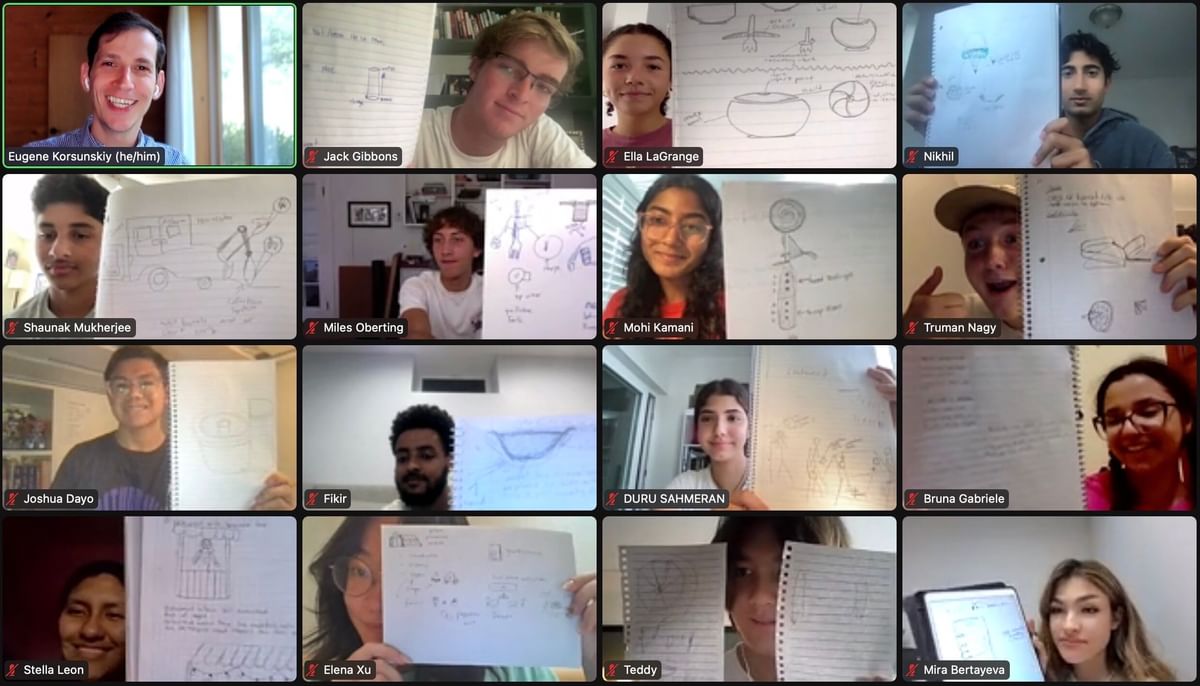- Undergraduate
Bachelor's Degrees
Bachelor of ArtsBachelor of EngineeringDual-Degree ProgramUndergraduate AdmissionsUndergraduate Experience
- Graduate
Graduate Experience
- Research
- Entrepreneurship
- Community
- About
-
Search
All Thayer News

High School Students Get Access to College-Level Design Thinking
Aug 29, 2023 | by Catha Mayor
An online summer "Introduction to Design Thinking" course for high-school students—modeled after a similar class at Dartmouth—just finished its fourth year and has gotten rave reviews. The course promises to teach "a multidisciplinary creative problem-solving methodology to create world-changing products and services and to tackle the most complex challenges of our time." We asked the instructor, Dartmouth Engineering professor Eugene Korsunskiy, who co-directs the Design Initiative at Dartmouth, about the secrets of the course's success:

What inspired you to make this curriculum available to high school students?
In 2020, when all of our regular classes were moving online, Dean Abramson and I thought, why limit the reach and benefit of a design education to just Dartmouth students? We decided to create a summer online course just for high school students, open to anyone in the world.
I taught the first instance of this class that summer, as a pilot, to see whether this intensive one-week online format could work. We got wonderful student reviews that year, so we've been running the program every summer since!
What seems to be the most impactful thing they're learning?
The biggest takeaway reported by students is the realization that design is all around us, that literally everything except nature—every product, system, service, and experience that we interact with—has been designed by someone. This understanding helps students be more astute observers of the human-made world, open to spotting not only the strengths but also potential weaknesses of the way in which our species has made our mark on the planet and its inhabitants.
We also introduce the idea that creativity can be learned and practiced, and that they have the power—and even the responsibility—to design a better world. They can and must contribute to designing better systems, processes, strategies, artifacts, and ideas to make the world a better place.
Through a series of design exercises, students watch their own creativity grow, and receive a visceral reinforcement of this idea: design is all around you, and you can be a designer who designs a better future. It's a really empowering realization.
Is there an advantage to introducing these ideas at a younger age?
One of the cornerstone ideas we cover is that you already have, within you, everything you need to be wildly creative. The trouble is, as we get older, we tend to get more and more "practical" and learn more and more facts about the world that tend to weigh down the kind of loose and unconstrained creativity that children often display. Yet, research has shown that coming up with world-changing innovations requires us to stretch the limits of our imagination and envision wild, far-out ideas that can inspire real breakthroughs.
Because of this, the earlier we teach people to question and challenge the constraints that they put on their own thinking, the easier it is to unlock their creative potential. This is one reason why it's important to teach design thinking to young people.
How do you make online learning fun and engaging?
We never do any one thing for a long period of time. Within each three-hour session, we constantly shift between short "lecturettes," group discussions, breakout room activities, individual exercises, and collaborative work, and we take breaks! No one should have to sit for three hours straight.
To further increase engagement throughout the week, each student is applying what they learn to a "Designing for Well-being" project where they develop an idea for a product, service, or experience to improve the physical, mental, social, or emotional well-being of someone they live with. This kind of relatable and rich topic helps ensure students are doing work they care about.
What else would you like people to know?
One of the joys of teaching this course has been the opportunity to interact with a global community. This summer, we had several students on the US West Coast for whom class started at 6am, and several students in China for whom class ended at midnight—and they were all awake and engaged!
In a single 20-person Zoom room, we've had people from Turkey, Singapore, Brazil, New Jersey, Peru, London, Canada, Kazakhstan, Minnesota, India, New York, Vietnam, and more—I've never had that kind of experience before (nor, it seemed, had any of the students), and that kind of perspective-sharing was valuable for all of us.
Student Testimonials
"I went into that course with a very different understanding of design. The limitations I had on myself before this course have been broken. This will be a massive win for me in later life."
"The class was flowing like a river of knowledge, making those three hours feel as if they were just 30 minutes in a cosmic time warp."
"Connecting with people from various parts of the world broadened my horizons and provided me with new perspectives."
"The process of refining and figuring out was amazing. Even if my product was not the best, in the end I definitely failed forward."
"An important skill which I have been taught is to focus on my wellbeing, and how I can apply design thinking into my own life."
"It has increased my hope for the future. As every unjust system has been designed, they can also be changed for the better. It helped me realize that I would be able to design for change and improve the lives of others."
"It felt incredibly empowering to think about how I could use design to reduce the prevalence of inequality in our world."
For contacts and other media information visit our Media Resources page.
